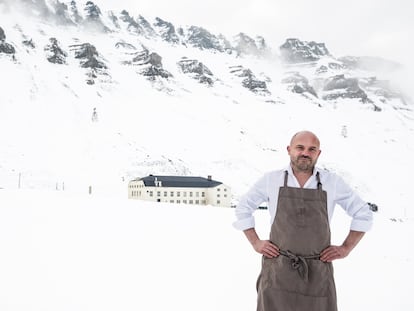From Nazi destruction to European cultural capital 2024: Bodø invites everyone to its latest rebirth
The Norwegian city, devastated by German bombing in 1940, went from a fishing town to a NATO air base. Today it is promoting its art, its landscapes and its future urban project
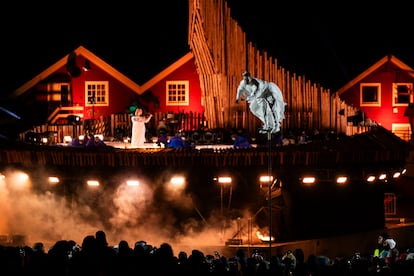
The first bomb arrived at dawn. The last fell as the afternoon was drawing to a close. By then, Bodø had been obliterated. On May 27, 1940, during World War II, German warplanes unloaded some 70 tons of explosives on this enclave in northern Norway. They sought to wipe out a radio station and an airstrip, but the fires caused by the bombardment devoured everything. It is estimated that more than half of the houses disappeared, taking the town’s history with them. The small community of fishermen and lumberjacks never returned. Bodø's reconstruction opted for modernity and cement. NATO installed an air base in the locality at the outset of the Cold War. Bodø grew to become an administrative center of almost 50,000 inhabitants. Facing the sea, surrounded by mountains, just as before. But different.
Last Saturday the city displayed another face. Instead of the noises of military exercises, there were street concerts, bicycles, and the sound of hundreds of passers-by. In short: life. And the culmination of a renaissance. Because Bodø has been chosen as the European cultural capital 2024: It now plays host to ambitious exhibitions, literary festivals, talks given in natural spaces or dancing in forest huts. Where nothing was left, today stands “the largest art project ever conceived in northern Norway,” according to the organization. For the first time, moreover, the EU’s recognition extends beyond the Arctic Circle.
More than 1,000 events and an investment of €30 million ($32.8 million), mostly in public funds, to vindicate Nordland, one of the roughest and most spectacular areas of Europe to which EL PAÍS was invited by the Embassy and the organization that promotes tourism in the region. No stereotypes “about ice and polar bears,” according to the program director of Bodø 2024, Henrik Sand Dagfinrud. The project aims to narrate a land as vast as Switzerland, but a very elongated territory of barely 240,000 inhabitants. Harsh and daunting, with weeks of light or darkness, it calls for endurance and adaptability to changing landscapes like few other places in the world. A “Norway in miniature,” as it is called. Bodø itself wants to start writing a different future. Although citizens’ visions of the next chapter differ and clash. Dialectics, after all, is also culture.
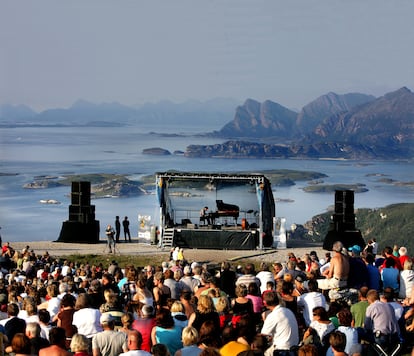
“The goal of Bodø 2024 is to help develop local talent while also working on the city’s international image,” notes Sand Dagfinrud. First, to put it on the map. And then on the travel plans of more tourists. Soccer fans may know it from the 6-1 humiliation Bodø Glimt inflicted on Roma, then coached by José Mourinho, in 2021. Some fans still recall with derision that the Portuguese blamed the defeat on the synthetic turf, among other reasons. The tide of yellow flags hanging from so many houses suggests that the club continues to provide joy. But Bodø is pursuing victories beyond the stadium.
The European Capital of Culture project anticipates some 500,000 visitors over the course of the year. Whether it’s the birthplace of Norwegian hip-hop, the art of the indigenous Sami people, the salmon skin bags sold by Elisabeth Benonisen at EBN or the “Arctic flavored” chocolate made by Craig Alibone at the bakery of the same name, everyone is sure to take home a souvenir. “It is noticeable in the number of people who come,” acknowledges Gonzalo Beamonte, head chef at Txaba, which since October 2023 has been offering Spanish dishes with a native touch. A port of passage, where you take the ferry to the Lofoten archipelago, Bodø asks to be noticed. And it has deployed hundreds of reasons to draw attention to itself.

Nature, art, and the transition to the future form the three pillars of the project. There are theater performances about the tragic legacy of World War II; an artistic collaboration with the African town of Segou; hiking spiced with poetry in Saltfjellet Park; or a food festival on the island of Herøy. Culture outside and inside Bodø. A walk through the city translates more ideas into practice: a full square in front of the Musikkfestuke stage; a constant coming and going of cyclists, in view of the Arctic race that is also part of the program; the main city museum refocused throughout the year on the Sami culture, repressed and discriminated against in the first half of the 20th century. All flooded with the brightness of the midnight sun, long summer weeks when it never gets dark and the Norwegians’ desire for activity soars. “In the morning, I went cross-country skiing in Sjunkhatte National Park, just an hour’s drive away. Later, I saw world-class performers with the Arctic Philharmonic at the Stormen center,” says Kristin, a 69-year-old retiree, in Now You’re Listening, a publication published by the Noua art gallery. And which, at the same time, reflects fears and concerns about the direction of Bodø.
Because the city is preparing to change again. Not because of the wars of others, this time, but by its own decision. The cultural capital is part of the latest reform: in 2012, the state relocated the air base, now closed. Hundreds of jobs were lost. It was a “shock,” according to Sand Dagfinrud, but also an opportunity. From this came the idea of applying to become an arts center by 2024. And also, to rework its map: Bodø is expected to move its airport a few hundred meters and build a new district on the 300 hectares that will be freed up. But how, and for what purpose?
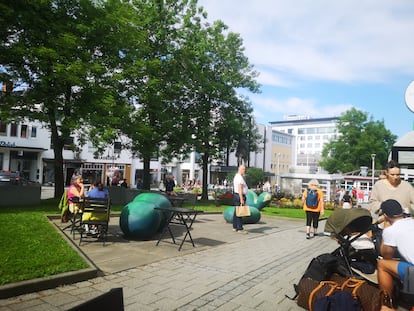
“The expansion of the city has been restricted by limited space. In the coming decades, Bodø will carry out one of Europe’s largest urban development projects,” the municipality says on its website, which foresees room for 30,000 residents and the creation of 20,000 jobs. The aim, according to the municipality, is to deal with the steadily increasing population, the departure of young people, and to create more business opportunities. Local citizens, however, do not share the same confidence.
Several voices denounce that local architecture is betraying Bodø's past: like raising the colossal and “unnecessary” Wood Hotel, on top of a hill, instead of small wooden cabins like those scattered along the coasts and forests of Nordland. “They may be looking to offset prejudices surrounding fishing towns,” confesses Roger Johansen, a resident and marketing manager for Northern Norway. The truth is that, as you move away from the center, the buildings give way to traditional houses. Two stories, a porch, often a trampoline or a slide in the garden. Bodø's bizarre development has often been blamed on the rush to rebuild. At times, old and new still mix. The modern restaurant Bryggerikaia offers elegant dishes with a view of the sea and young boys in bathing trunks playing at pushing each other along the quay. But the hotel capacity has doubled in a decade. Excessive, for the skeptics. Smart, for its promoters.
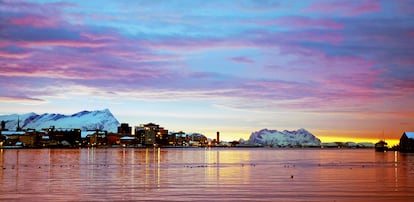
Two foreigners linked to the region, Gonzalo Beamonte and Italian writer Davide S. Sapienza, agree on the criticism: a very capitalist country, with rivers of money from its natural resources and, lately, debatable ideas on how to spend it. Although both also surrender to the landscapes that surround Bodø and amaze from virtually every corner of Nordland. Not for nothing is this often repeated as the main reason given by the interviewees in local magazine Now You’re Listening to Us to explain why they live here.
A reason, at the moment, that is rubbing off on tourists as well. “They are usually conscientious people. You don’t come here to party, but for nature,” says Beamonte. The city has obtained national certification as a Sustainable Destination. It doesn’t mean that it is 100% sustainable, but it does mean that it is working to reduce the negative effects of tourism. Marie Peyre, a Frenchwoman who has lived in Norway for years and is now press officer for Bodø 2024, says: “I think it attracts those who are looking for something different, those who prefer ice bathing rather than sunbathing; those who are looking for a bit of adventure. It’s not for everyone and certainly not for the faint of heart.” Judging by the history, shocks are guaranteed. Judging by the surroundings, joys too.
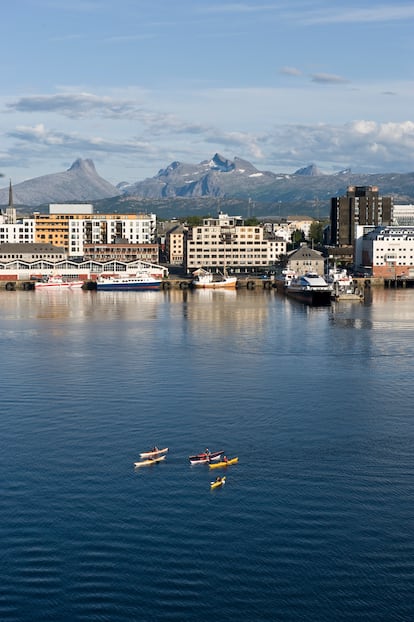
Sign up for our weekly newsletter to get more English-language news coverage from EL PAÍS USA Edition
Tu suscripción se está usando en otro dispositivo
¿Quieres añadir otro usuario a tu suscripción?
Si continúas leyendo en este dispositivo, no se podrá leer en el otro.
FlechaTu suscripción se está usando en otro dispositivo y solo puedes acceder a EL PAÍS desde un dispositivo a la vez.
Si quieres compartir tu cuenta, cambia tu suscripción a la modalidad Premium, así podrás añadir otro usuario. Cada uno accederá con su propia cuenta de email, lo que os permitirá personalizar vuestra experiencia en EL PAÍS.
¿Tienes una suscripción de empresa? Accede aquí para contratar más cuentas.
En el caso de no saber quién está usando tu cuenta, te recomendamos cambiar tu contraseña aquí.
Si decides continuar compartiendo tu cuenta, este mensaje se mostrará en tu dispositivo y en el de la otra persona que está usando tu cuenta de forma indefinida, afectando a tu experiencia de lectura. Puedes consultar aquí los términos y condiciones de la suscripción digital.
More information
Archived In
Últimas noticias
Maduro pleads not guilty before the federal court in New York: ‘I am still the president of Venezuela’
A new test can detect Alzheimer’s from a finger prick
UN team enters Sudanese city of El Fasher after paramilitary massacre: ‘It’s like a ghost town’
A recipe for resistance: Indigenous peoples politicize their struggles from the kitchen
Most viewed
- Gilles Lipovetsky: ‘If you want to live better and fall in love, take Prozac, don’t look to philosophy’
- Alain Aspect, Nobel laureate in physics: ‘Einstein was so smart that he would have had to recognize quantum entanglement’
- Alvin Hellerstein, a 92-year-old judge appointed by Bill Clinton, to preside over Maduro’s trial in New York
- Why oil has been at the center of Venezuela-US conflicts for decades
- Maduro’s downfall puts China’s relationship with Venezuela to the test


